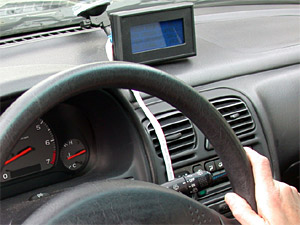(Source: Wired)

Top photo: Flickr / Phil Hawksworth.
Editor’s note: Robin Chase thinks a lot about transportation and the internet, and how to link them. She connected them when she founded Zipcar, and she wants to do it again by making our electric grid and our cars smarter. Time magazine recently named her one of the 100 most influential people of the year. David Weinberger sat down with Chase to discuss her idea.
Robin Chase considers the future of electricity, the future of cars and the internet three terms in a single equation, even if most of us don’t yet realize they’re on the same chalkboard. Solve the equation correctly, she says, and we create a greener future where innovation thrives. Get it wrong, and our grandchildren will curse our names.
Chase thinks big, and she’s got the cred to back it up. She created an improbable network of automobiles called Zipcar. Getting it off the ground required not only buying a fleet of cars, but convincing cities to dedicate precious parking spaces to them. It was a crazy idea, and it worked. Zipcar now has 6,000 cars and 250,000 users in 50 towns.
Now she’s moving on to the bigger challenge of integrating a smart grid with our cars – and then everything else. The kicker is how they come together. You can sum it up as a Tweet: The intelligent network we need for electricity can also turn cars into nodes. Interoperability is a multiplier. Get it right!
Chase starts by explaining the smart grid. There’s broad consensus that our electrical system should do more than carry electricity. It should carry information. That would allow a more intelligent, and efficient, use of power.
“Our electric infrastructure is designed for the rare peak of usage,” Chase says. “That’s expensive and wasteful.”
Changing that requires a smart grid. What we have is a dumb one. We ask for electricity and the grid provides it, no questions asked. A smart grid asks questions and answers them. It makes the meter on your wall a sensor that links you to a network that knows how much power you’re using, when you’re using it and how to reduce your energy needs – and costs.
Such a system will grow more important as we become energy producers, not just consumers. Electric vehicles and plug-in hybrids will return power to the grid. Rooftop solar panels and backyard wind turbines will, at times, produce more energy than we can store. A smart grid generates what we need and lets us use what we generate. That’s why the Obama Administration allocated $4.5 billion in the stimulus bill for smart grid R&D.
This pleases Chase, but it also makes her nervous. The smart grid must be an information network, but we have a tradition of getting such things wrong. Chase is among those trying to convince the government that the safest and most robust network will use open internet protocols and standards. For once the government seems inclined to listen.
Chase switches gears to talk about how cars fit into the equation. She sees automobiles as just another network device, one that, like the smart grid, should be open and net-based.
“Cars are network nodes,” she says. “They have GPS and Bluetooth and toll-both transponders, and we’re all on our cell phones and lots of cars have OnStar support services.”
That’s five networks. Automakers and academics will bring us more. They’re working on smart cars that will communicate with us, with one another and with the road. How will those cars connect to the network? That’s the third part of Chase’s equation: Mesh networking.
In a typical Wi-Fi network, there’s one router and a relatively small number of devices using it as a gateway to the internet. In a mesh network, every device is also a router. Bring in a new mesh device and it automatically links to any other mesh devices within radio range. It is an example of what internet architect David Reed calls “cooperative gain” – the more devices, the more bandwidth across the network. Chase offers an analogy to explain it.
“Wi-Fi is like a bridge that connects the highways on either side of the stream,” she says. “You build it wide enough to handle the maximum traffic you expect. If too much comes, it gets congested. When not enough arrives, you’ve got excess capacity. Mesh takes a different approach: Each person who wants to cross throws in a flat rock that’s above the water line. The more people who do that, the more ways there are to get across the river.”
“Today in Iraq and Afghanistan, soldiers and tanks and airplanes are running around using mesh networks,” said Chase. “It works, it’s secure, it’s robust. If a node or device disappears, the network just reroutes the data.”
And, perhaps most important, it’s in motion. That’s what allows Chase’s plural visions to go singular. Build a smart electrical grid that uses Internet protocols and puts a mesh network device in every structure that has an electric meter. Sweep out the half dozen networks in our cars and replace them with an open, Internet-based platform. Add a mesh router. A nationwide mesh cloud will form, linking vehicles that can connect with one another and with the rest of the network. It’s cooperative gain gone national, gone mobile, gone open.
Chase’s mesh vision draws some skepticism. Some say it won’t scale up. The fact it’s is being used in places like Afghanistan and Vienna indicates it could. Others say moving vehicles may not be able to hook into and out of mesh networks quickly enough. Chase argues it’s already possible to do so in less than a second, and that time will only come down. But even if every car and every electric meter were meshed, there’s still a lot of highway out there that wouldn’t be served, right? Chase has an answer for that, too.
Click here to read the entire article.









